Poultry Diseases
A disease is an abnormal condition that is caused by infection, basic weaknesses, or environmental stress. Diseases can be categorized by common causes, such as
genetic,
mechanical,
toxic,
and nutritional.
Infectious diseases are caused by germs such as viruses, bacteria, and fungi. Parasitic diseases are caused by protozoa, worms, and external parasites such as mites and lice. These diseases can affect all poultry birds, including fowls, turkeys, ducks, and geese etc.
Poultry Diseases can cause significant economic losses and even lead to the death of birds. According to the World Organization for Animal Health (OIE), around 20% of the world’s chicken population is infected with at least one poultry disease. Poultry are quite susceptible to a number of diseases. Some of the more common are fowl typhoid, pullorum, fowl cholera, chronic respiratory disease, infectious sinusitis, infectious coryza, avian infectious hepatitis, infectious synovitis, bluecomb, Newcastle disease, fowl pox, avian leukosis complex, coccidiosis, blackhead, infectious laryngotracheitis, infectious bronchitis, and erysipelas. Strict sanitary precautions, the intelligent use of antibiotics and vaccines, and the widespread use of cages for layers and confinement rearing for broilers have made it possible to effect satisfactory disease control( Garrigus 2023). Others include bird flu, or avian influenza with the primary host being waterfowl such as wild ducks . Sick birds pass the viruses to healthy birds through saliva, nasal secretions, and droppings. Humans who are in close contact with sick birds—for example, poultry farmers and slaughterhouse workers—are at the greatest risk of becoming infected.
Parasitic diseases of poultry, including hexamitiasis of turkeys, are caused by roundworms, tapeworms, lice, and mites etc.
EFFECT OF POULTRY DISEASES
1. Reduce farmer’s income
2. Some diseases are contagious to human and other animals
3. Diseases can cause the death of birds
4. Certain diseases have the potential to decimate a region’s poultry industry.
5. When a disease strikes, a quarantine or embargo could suddenly be placed on a region or nation.
6. This could cause widespread economic hardship for both commercial and small flock owners.
Therefore, poultry farmers must be able to identify diseases quickly to prevent them from spreading to other animals. The sooner a disease is identified and action is taken, the better.
HOW POULTRY DISEASES ARE SPREAD
Diseases are spread by:
1. Direct contact – bird-to-bird or contact with infected manure
2. Indirect contact – contaminated equipment, people, and environment
3. Vectors – spread by wild animals, rodents, insects)
4. Pathogens – bacteria, viruses and fungi
5. Malnutrition – not consuming a balanced diet feed
POULTRY DISEASES, CAUSATIVE AGENTS, SYMPTOMS, PREVENTION AND TREATMENT
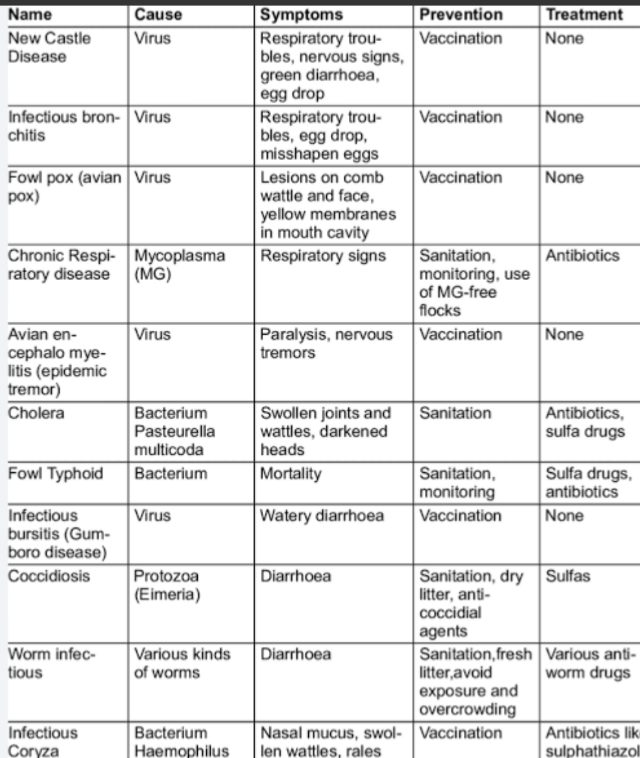
Coccidiosis
Coccidiosis is a poultry disease caused by a protozoan parasite that resides in the walls of the chicken’s intestine and will kill the chicken at any age. It is caused by 8-9 species of protozoa of the genus Eimeria. Birds get infected through contaminated food, water or wet litter.
Signs and symptoms
Bloody droppings , pale comb, listlessness with droopy wings and ruffled feathers, loss of appetite, standing with the eyes closed and huddling together in corners.
Treatment
Coccidiosis can be treated with coccidiostats such as amprolium and sulpha drugs. Anti-coccidial drugs that can be used to treat coccidiosis include Prococ, Amprocox, Coxstop, Coccicare and Sulmet.

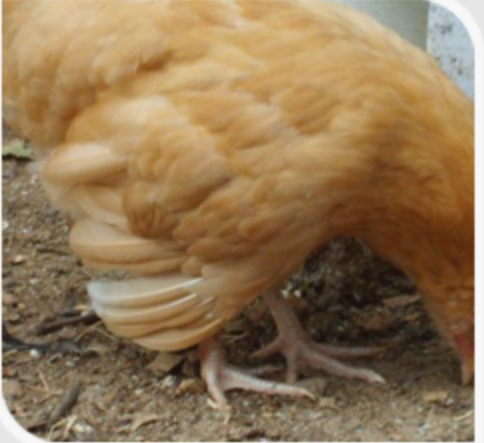

Fowl Pox
Fowl pox is a viral disease that could be transmitted through body wounds or scratches, a vector carrying the virus (e.g., mosquitos) and through the air.
Signs and symptoms
pox lesions on wattles, comb and/or legs, discharge from nostrils, white ulcers or cheesy membrane in the mouth, loss of appetite, a decline in egg production, foamy materials in corners of eyes or white spots on the skin.
Treatment
Since this is a viral disease, there is no exact drug. However, you should remove the necrotic membrane from the affected fowl’s mouth and larynx. You can stimulate appetite with wet feed (mash) and add antibiotics and multivitamins to their drinking water. Ensure that you use good disinfectant during the outbreak of the disease.
To prevent Fowl Pox, you need to vaccinate the fowl with the Fowl Pox vaccine and control mosquitoes in and around the fowl cages or housing units
Marek’s Disease
Marek’s Disease (MD), also known as “bird paralysis, Fowl paralysis, neurolymphomatosis gallinarum, or visceral leukosis” is a highly contagious viral disease that affects poultry, causing weakness or complete paralysis of the bird’s legs and sometimes other parts of the body. It is characterized by T-cell lymphomas and peripheral nerve enlargement.
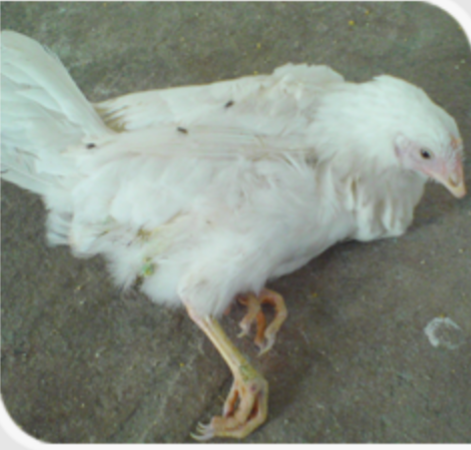
Newcastle Disease
Newcastle disease (also known as Ranikhet disease) is a viral disease that is caused by paramyxoviruses. These viruses are of various types. This disease can be transmitted through the air, feed, water and carrier birds.
Signs and symptoms
With very harmful paramyxoviruses, the first sign is sudden death. Other signs like weakness, depression, greenish diarrhea, lying down, swelling of the face and nervous signs will also be observed. Torticollis (twisting of the neck), leg paralysis, and arching of the body are some other indications of Newcastle disease. In layers, laying of soft-shelled or shell-less eggs is an early sign, followed by a halting of egg laying. Moderately harmful paramyxoviruses are responsible for severe respiratory problems. In adult chickens, there is usually an obvious decline in egg production for many months. However, the mortality rate is low. The mildly harmful paramyxoviruses may not cause any disease or just mild respiratory problems.
Treatment
Newcastle disease has no treatment, but can be prevented through vaccination, maintaining a high level of farm hygiene, good management and biosecurity measures.
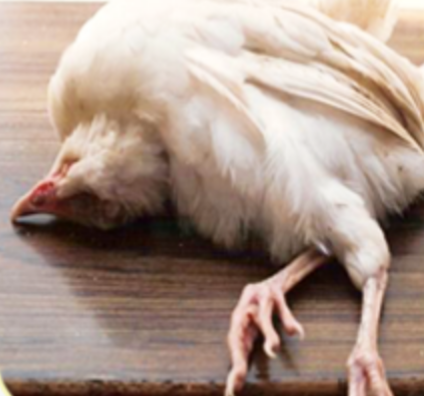
Infectious Bronchitis
This is a rapid, sudden and highly contagious viral poultry disease. It’s caused by a coronavirus and could be transmitted through the air, contaminated materials and carrier hosts.
Signs and symptoms
Abnormal respiratory sounds, snoring, gasping, sneezing and coughing, watery nasal discharge, ocular discharge and swelling of the face. Reduced egg production and poor egg shell quality. Watery albumen.
Treatment
Infectious bronchitis has no specific treatment, but you can administer antibiotics in mixed infections. You should also take affected fowls to a warm, dry place to recover. Some farmers have tried warm herb tea and fresh herbs, and they claimed they worked.
To prevent Infectious Bronchitis, vaccinate your chickens against the disease and maintain proper ventilation of chicks.
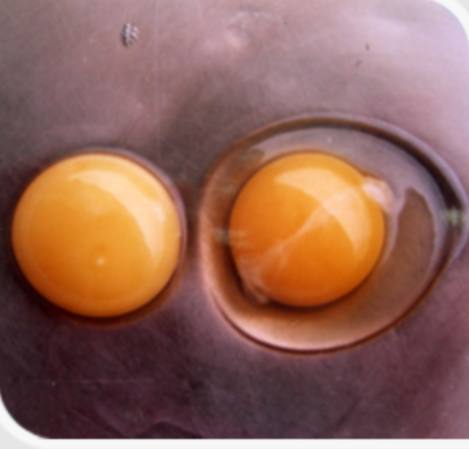
Fowl Cholera (Avian Pasteurellosis)
Fowl Cholera is a highly contagious bacterial disease that affects poultry birds. It is caused by Pasteurella multocida and could be transmitted through ingestion of contaminated food and water or from a carrier host chicken.
Signs and symptoms
Yellowish or greenish diarrhea, difficulty in breathing, swollen joint, purple comb and wattle, oral, nasal and ocular discharges, ruffled feathers and loss of appetite.
Treatment
Fowl cholera can be treated with penicillin, streptomycin, erythromycin, tetracyclines and sulphonamides. You will need to administer drugs for the long term because the disease usually returns after stopping the medication.
To prevent Fowl Cholera, administer the F. Cholera vaccine and maintain a high level of farm hygiene and sanitation. Prevent rodents, cats and wild birds from gaining access to the pen.
Infectious Coryza
Infectious Coryza or Fowl Coryza is a severe respiratory disease that affects chicken and it could be sudden. This disease is common in layers and broilers and it is caused by Haemophilus paragallinarum. It could be transmitted through water contaminated with nose discharges, through the air, or direct contact with an infected chicken.
Signs and symptoms
Swelling of the head (comb, wattle and eyes), sneezing, stringy discharge from the nose and eyes, conjunctivitis with closed eyes, difficulty in breathing and moisture under the wings. Other symptoms of infectious coryza include reduced feed and water consumption and a huge drop or halt in egg production.
Treatment
Infectious Coryza can be treated with antibiotics and sulpha drugs. Oxytetracycline, enrofloxacin, trimethoprim and sulpha drug can be combined to treat infectious coryza.
Chickens can be protected from infectious coryza through vaccination. Dispose of all infected chickens or those that had recovered. Sanitation and hygiene and avoid keeping chickens of different ages together.
AVIAN INFLUENZA
Avian influenza (AI) is a respiratory disease of birds. AI viruses can infect chickens, turkeys, pheasants, quail, ducks, geese, and guinea fowl, as well as a wide variety of other birds. Migratory waterfowl seem to be a natural host for AI viruses. This viruse is classified according to the severity of illness they cause. AI viruses can be classified into low pathogenic and highly pathogenic based on the severity of the illness they cause in birds.
How AI Is Spread: AI viruses spread primarily by direct contact between healthy and infected birds through respiratory secretions and feces. The disease can spread through: Exposure of poultry to wild waterfowl, Illegal international movement of birds, Movement of people and farm equipment, Smuggling of poultry and poultry products, Contaminated poultry equipment (such as cages and crates, manure, vehicles, and egg flats) and people whose clothing or shoes have come into contact with the virus and direct bird-to-bird contact
Signs and symptoms
Sudden death without clinical signs, lack of energy and appetite, decreased egg production and/or soft-shelled or misshapen eggs, swelling of the head, eyelids, comb, wattles, and legs, purple discoloration of the wattles, combs, and legs, nasal discharge, coughing, and sneezing, lack of coordination, and diarrhea
Prevention and treatment
House poultry indoors, avoid the use of farm ponds and bird feeders, avoid all contact with wild and domestic waterfowl, avoid live bird markets, control cats, rodents, beetles, insects, and other pests, seek diagnostic help on unusual deaths, avoid contact with your flock if working in poultry or swine processing, avoid sharing equipment. Borrowed equipment should be thoroughly clean and disinfected.
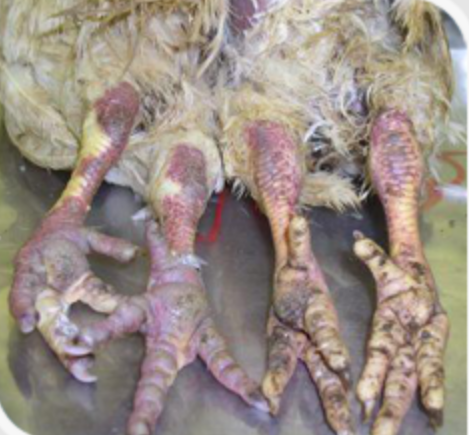
BUMBLEFOOT IN POULTRY
Bumblefoot in poultry is a condition that affects fowls and other birds, causing infection and swelling in the feet. It is typically caused by bacterial infection, often Staphylococcus aureus, that enters through small cuts or abrasions on the foot. The infection leads to the formation of abscesses, which can be very painful and may affect the bird’s ability to walk.
CAUSES:
Bumblefoot can be caused by several factors that open door for the bacterial infection. Such factors include:
a. Poor perches or flooring: Hard, rough surfaces, or areas with high moisture can cause abrasions on the feet.
b. Injury or trauma: Scratches or cuts on the feet are common entry points for the bacteria.
c. Obesity: Overweight bird may put extra pressure on their feet, making them more prone to developing bumblefoot.
d. Poor sanitation: Dirty, wet bedding or environments can increase the risk of bacterial infections.
COMMON SYMPTOMS OF BUMBLEFOOT:
-Swelling and redness on the foot pads
-A hard, raised abscess or scab on the foot
-Lameness or difficulty in walking
-Heat or pain in the affected area
-In severe cases, pus or discharge might be visible from the abscess
TREATMENT AND PREVENTION
TREATMENT
1. Soaking the foot: Soaking the affected foot in warm water or an antiseptic solution can help soften the scab and make it easier to treat.
2. Cleaning and removal of the abscess: Gently clean the affected area and, if necessary, surgically remove the abscess, being careful to disinfect the area thoroughly.
3. Antibiotics: Oral or topical antibiotics may be prescribed if an infection is present.
4. Bandaging: Keeping the foot clean and bandaged can help prevent further infection and aid healing.
5. Pain management: In some cases, pain relief may be necessary, depending on the severity of the infection.
PREVENTION
a. Ensure clean, dry bedding and regularly clean the chicken coop.
b. Provide soft, non-slip surfaces for perching to prevent injury.
c. Avoid overcrowding and ensure the birds have enough space to move around comfortably.
d. Maintain a healthy diet to prevent obesity, which can put extra strain on the feet.
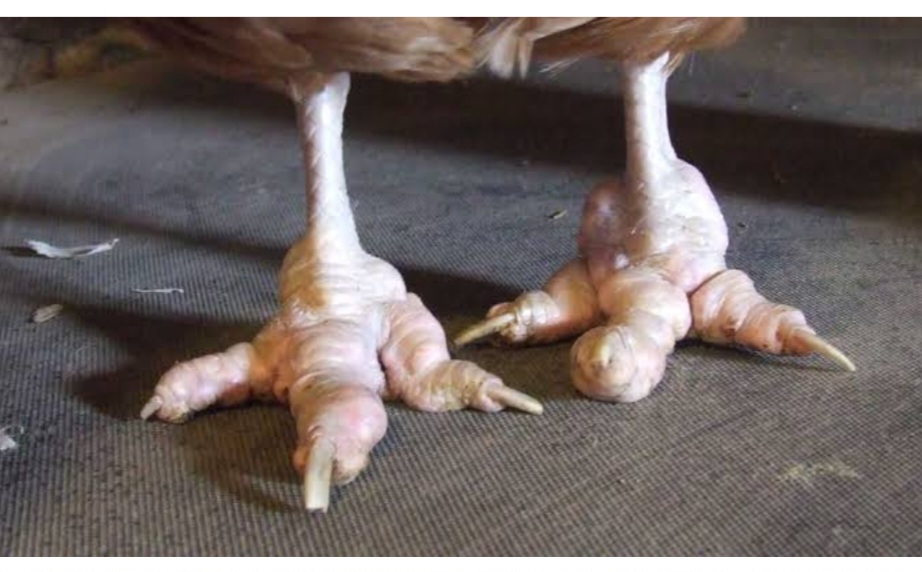
If the condition is left untreated, it can lead to further complications, including systemic infection or permanent lameness. It is important to address bumblefoot as soon as possible to prevent these complications.
GUMBORO DISEASE
Gumboro disease, also known as Infectious Bursal Disease (IBD), is a viral infection that affects poultry, primarily young birds, and can cause significant damage to their immune system.
SYMPTOMS
Gomboro disease in fowl is characterized by symptoms like depression, ruffled feathers, watery diarrhea, and reduced feed and water consumption, often affecting birds between 3 and 6 weeks old. Infected chicks appear listless and may huddle or sit in a hunched position (sign of depression). They release watery or mucoid (slimy) diarrhea , often with soiled vent feathers. Other signs include; Anorexia (Loss of appetite is a common sign),Vent Pecking, unsteady or wobbly gait, tremors or trembling may be observed and hemorrhages ( at the thigh and pectoral muscles).
PREVENTION AND TREATMENT
PREVENTION. Preventing Gumboro disease in a poultry farm involves several key management practices:
1. Vaccination
a. Proper Vaccination Program: Vaccinate your birds at the right age using vaccines designed for Gumboro disease. The vaccination schedule typically includes:a. Initial vaccination for day-old chicks or at 7-14 days of age.
b. Booster doses at regular intervals, especially during high-risk periods.
c. Consult with a vet to determine the appropriate type of vaccine (live or inactivated) based on your flock’s needs.
2. Biosecurity Measuresa.
a. Strict Hygiene: Ensure cleanliness in the poultry house. Disinfect equipment, feed, and water troughs regularly.
b. Control Movement: Limit the entry of visitors, vehicles, and animals into the farm. Use footbaths and hand sanitizers at entry points.
c. Isolate New Birds: Quarantine any new or incoming birds for a few weeks to ensure they are not carrying infections.
3. Good Farm Management Practices
a. Adequate Ventilation: Maintain proper air circulation in poultry houses to reduce the buildup of harmful viruses.
b. Optimal Temperature and Humidity: Maintain the right environmental conditions to reduce stress on the birds, which can weaken their immune system.
c. Proper Feed and Water: Ensure that birds receive balanced nutrition and clean water. Proper diet strengthens their immune system to resist infections.
4. Monitor and Control Stress
a. Reduce Stress Factors: Keep the birds free from stress caused by overcrowding, poor ventilation, or poor handling, as stress can lower immunity and increase susceptibility to diseases.
b. Monitor for Symptoms: Be on the lookout for any signs of disease, such as lethargy, loss of appetite, diarrhea, or sudden deaths, and consult a veterinarian immediately if you suspect an outbreak.
5. Use of Antibodies (Passive Immunity) Colostrum or Maternal Antibodies: Ensure chicks receive adequate passive immunity from their mothers, especially if the hens have been vaccinated against Gumboro. This can help protect the chicks during the early stages of life.
6. Infection Control and Early Detection
a. Routine Health Checks: Regularly inspect birds for any signs of illness and report to a vet if you suspect an outbreak.
b. Prompt Isolation: If Gumboro is suspected in a flock, isolate infected birds immediately to prevent the virus from spreading to healthy ones. By following these strategies, farmers can significantly reduce the risk of Gumboro disease on your poultry farm.
TREATMENT
Gumboro disease, or Infectious Bursal Disease (IBD), has no specific cure, meaning there is no antiviral medication or treatment that can directly eliminate the IBD virus. So treatment focuses on supportive care and preventing secondary infections.
Prevention through vaccination and strict biosecurity measures is crucial as stated above.
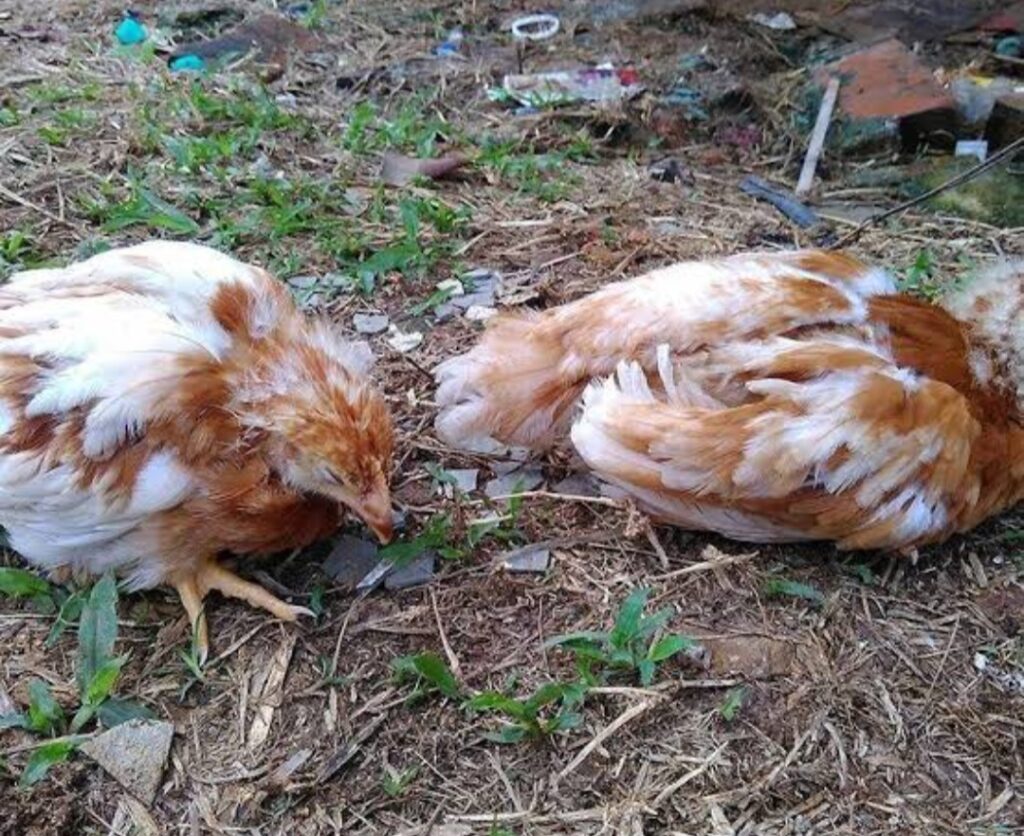
Supportive care may include; focusing on alleviating symptoms and preventing complications. Give vitamin and electrolyte supplements to help maintain hydration and support the bird’s weakened immune system. And lastly, administer antibiotics if secondary bacterial infections develops.
STEPS TO TAKE WHEN A DISEASE IS NOTICED ON THE FARM OR TO REDUCE IT
To prevent a disease from spreading from one bird to more birds—both within your flock and to other flocks in other farms, take the following precautions:
1. Separate the sick bird(s) from the rest of the flock and isolate them
2. Reduce the number of visitors that visit the farm and if visitors visit, they should adhere to the farm biosecurity precautions
3. Wash and disinfect all equipment that come into contact with your flock or property
4. Disinfect your clothing and footwear after contact with the sick bird(s) or its environment;
5. Contact your veterinarian.
When a bird shows signs of being ill, symptoms alone may not be enough to diagnose a particular disease, since some diseases share similar symptoms. You should ask your local veterinarian to diagnose all unidentified illnesses. If you do not have a veterinarian, contact your county extension office
Note: Prevention is better than cure. Diseases can wipe off a whole flock within a day. Let’s make sure our birds are taken care of.
